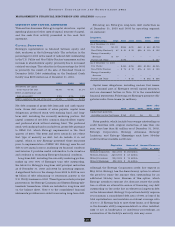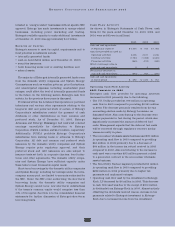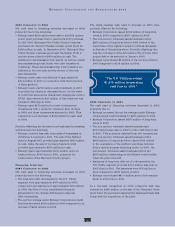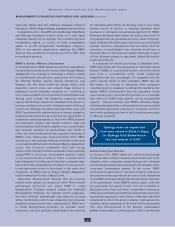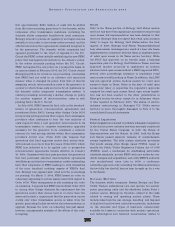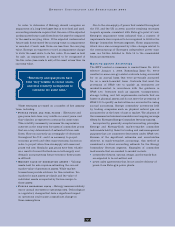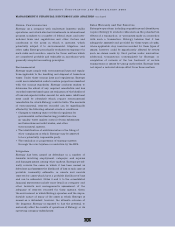Entergy 2003 Annual Report Download - page 40
Download and view the complete annual report
Please find page 40 of the 2003 Entergy annual report below. You can navigate through the pages in the report by either clicking on the pages listed below, or by using the keyword search tool below to find specific information within the annual report.
38
ENTERGY CORPORATION AND SUBSIDIARIES 2003
MANAGEMENT’S FINANCIAL DISCUSSION AND ANALYSIS
continued
EKT also has master netting agreements in place.
These agreements allow EKT to offset cash and
non-cash gains and losses arising from derivative
instruments with the same counterparty. EKT’s policy
is to have such master netting agreements in place
with significant counterparties.
Based on EKT’s policies, risk exposures, and valuation
adjustments related to credit, EKT does not anticipate a
material adverse effect on its financial position as a result
of counterparty nonperformance. As of December 31, 2003,
approximately 91% of EKT’s counterparty credit exposure
is associated with companies that have at least investment
grade credit ratings.
Following are EKT’s mark-to-market assets (liabilities)
and the period within which the assets (liabilities) would be
realized (paid) in cash if they are held to maturity and
market prices are unchanged (in millions):
Maturities and Sources
for Fair Value of Trading 0-12 13-24 25+
Contracts at December 31, 2003 months months months Total
Prices actively quoted $126.3 $(87.1) $(14.6) $24.6
Prices provided by
other sources 4.8 (10.1) 5.6 0.3
Prices based on models (28.0) 14.2 4.9 (8.9)
Total $ 103.1 $ (83.0) $ (4.1) $ 16.0
Following is a roll-forward of the change in the fair value
of EKT’s mark-to-market contracts during 2003 (in millions):
2003
Fair value of contracts outstanding
at December 31, 2002 after implementation
of Emerging Issues Task Force (EITF) 02-03 $ 90.9
(Gain)/loss from contracts
realized/settled during the year (580.0)
Net option premiums received during the year 275.7
Change in fair value of contracts attributable
to market movements during the year 229.4
Net change in contracts outstanding
during the year (74.9)
Fair value of contracts at December 31, 2003 $ 16.0
Foreign Currency Exchange Rate Risk
Entergy Gulf States, System Fuels, and Entergy’s Non-
Utility Nuclear business enter into foreign currency forward
contracts to hedge the Euro-denominated payments due
under certain purchase contracts. The notional amounts of
the foreign currency forward contracts are 142.8 million
Euro and the forward currency rates range from .8641 to
1.085. The maturities of these forward contracts depend on
the purchase contract payment dates and range in time
from January 2004 to January 2007. The mark-to-market
valuation of the forward contracts at December 31, 2003
was a net asset of $50 million. The counterparty banks
obligated on these agreements are rated by Standard &
Poor’s Rating Services at AA on their senior debt obligations
as of December 31, 2003.
Interest Rate and Equity Price Risk -
Decommissioning Trust Funds
Entergy’s nuclear decommissioning trust funds are
exposed to fluctuations in equity prices and interest rates.
The Nuclear Regulatory Commission (NRC) requires
Entergy to maintain trusts to fund the costs of decommis-
sioning ANO 1, ANO 2, River Bend, Waterford 3, Grand
Gulf 1, Pilgrim, Indian Point 1 and 2, and Vermont Yankee
(NYPA currently retains the decommissioning trusts and
liabilities for Indian Point 3 and FitzPatrick). The funds are
invested primarily in equity securities; fixed-rate, fixed-
income securities; and cash and cash equivalents.
Management believes that exposure of the various funds to
market fluctuations will not affect Entergy’s financial
results of operations as it relates to the ANO 1 and 2, River
Bend, Grand Gulf 1, and Waterford 3 trust funds because of
the application of regulatory accounting principles. The
Pilgrim, Indian Point 1 and 2, and Vermont Yankee trust
funds collectively hold approximately $895 million of fixed-
rate, fixed-income securities as of December 31, 2003. These
securities have an average coupon rate of approximately
5.6%, an average duration of approximately 5.2 years, and
an average maturity of approximately 7.9 years. The
Pilgrim, Indian Point 1 and 2, and Vermont Yankee trust
funds also collectively hold equity securities worth
approximately $450 million as of December 31, 2003. These
securities are generally held in funds that are designed to
approximate or somewhat exceed the return of the Standard
& Poor’s 500 Index, and a relatively small percentage of the
securities are held in a fund intended to replicate the return
of the Wilshire 4500 Index. The decommissioning trust
funds are discussed more thoroughly in Notes 1 and 9 to
the consolidated financial statements.
UTILITY RESTRUCTURING
In Entergy’s U.S. Utility service territory, movement to
retail competition either has not occurred or has been
abandoned, with the exception of Texas, where it has been
significantly delayed. At FERC, the pace of restructuring at
the wholesale level has begun but has also been delayed. It
is too early to predict the ultimate effects of changes in U.S.
energy markets. Restructuring issues are complex and are
continually affected by events at the national, regional,
state, and local levels. These changes may result, in the
long-term, in fundamental changes in the way traditional
integrated utilities and holding company systems, like the
Entergy system, conduct their business. Some of these
changes may be positive for Entergy, while others may not be.


